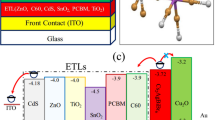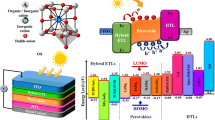Abstract
In recent years, the intense demand, because of attitude to renewable and the non-biodegradable energy have accelerated the transformations of solar cell technologies, especially, Pb-based halides perovskite solar cells attracted the attention of researchers. One of the advantages of these cells is the low cost due to the use of cost-effective materials -in addition to- the construction methods in their structure, but these cells face challenges such as inadequate stability and hysteresis. This paper is about investigation of the planar and inverted structure of Perovskite Solar Cells (PSCs) with the inorganic hole transport layer, which has relatively less vulnerability to the instability and hysteresis that show acceptable efficiency. The proposed and examined structure in the research includes two new arrangements including a layer of CH3NH3SnI3. Initially, the power conversion efficiency in this structure was obtained 11% by using simulation which compared and validated through experimental work. Then, the simulation results have shown an increase in the power conversion efficiency by adding a CH3NH3SnI3 layer to the structure from 11.94% to 23.21%. The best power conversion efficiency has been observed by the 300 nm thickness of the CH3NH3SnI3 layer.






Similar content being viewed by others
References
Abdelaziz, S., Zekry, A., Shaker, A., Abouelatta, M.: Investigating the performance of formamidinium tin-based perovskite solar cell by scaps device simulation. Opt. Mater. 101, 109738 (2020)
Ahmed, S., Jannat, F., Khan, M.A.K., Alim, M.A.: Numerical development of eco-friendly cs2tibr6 based perovskite solar cell with all-inorganic charge transport materials via scaps-1d. Optik 225, 165765 (2020)
Anaya, Miguel, Correa-Baena, Juan P., Lozano, Gabriel, Saliba, Michael, Anguita, Pablo, Roose, Bart, Abate, Antonio, Steiner, Ullrich, Grätzel, Michael, Calvo, MauricioE., et al.: Optical analysis of ch 3 nh 3 sn x pb 1–x i 3 absorbers: a roadmap for perovskite-on-perovskite tandem solar cells. J. Mater. Chem. A 4(29), 11214–11221 (2016)
Burgelman, M., Nollet, P., Degrave, S.: Modelling polycrystalline semiconductor solar cells. Thin Solid Films 361, 527–532 (2000)
Christians, J.A., Fung, R.C.M., Kamat, P.V.: An inorganic hole conductor for organo-lead halide perovskite solar cells improved hole conductivity with copper iodide. J. Am. Chem. Soc. 136(2), 758–764 (2014)
Christian Wehrenfennig, Giles E Eperon, Michael B Johnston, Henry J Snaith, and Laura M Herz. High charge carrier mobilities and lifetimes in organolead trihalide perovskites. Adv. Mater., 26 (10): 1584–1589, 2014
Dashtian, K., Hajati, S., Ghaedi, M.: Ti-based solid-state imprinted-cu2o/cuinse2 heterojunction photoelectrochemical platform for highly selective dopamine monitoring. Sens. Actuat. B: Chem. 326, 128824 (2021)
Gao, P., Grätzel, M., Nazeeruddin, M.: Organohalide lead perovskites for photovoltaic applications. Energy Environ. Sci. 7(8), 2448–2463 (2014)
Homes, C.C., Vogt, T., Shapiro, S.M., Wakimoto, S., Ramirez, A.P.: Optical response of high-dielectric-constant perovskite-related oxide. Science 293(5530), 673–676 (2001)
Hossain, M.I., Alharbi, F.H., Tabet, N.: Copper oxide as inorganic hole transport material for lead halide perovskite based solar cells. Sol. Energy 120, 370–380 (2015)
Im, J.-H., Lee, C.-R., Lee, J.-W., Park, S.-W., Park, N.-G.: 6.5% efficient perovskite quantum-dot-sensitized solar cell. Nanoscale 3(10), 4088–4093 (2011)
Im, J.-H., Jang, I.-H., Pellet, N., Grätzel, M., Park, N.-G.: Growth of ch 3 nh 3 pbi 3 cuboids with controlled size for high-efficiency perovskite solar cells. Nat. Nanotechnol. 9(11), 927–932 (2014)
Imahori, H., Umeyama, T., Ito, S.: Large π-aromatic molecules as potential sensitizers for highly efficient dye-sensitized solar cells. Acc. Chem. Res. 42(11), 1809–1818 (2009)
Irwin, M.D., Buchholz, D.B., Hains, A.W., Chang, R.P.H., Marks, T.J.: p-type semiconducting nickel oxide as an efficiency-enhancing anode interfacial layer in polymer bulk-heterojunction solar cells. Proc. Natl. Acad. Sci. 105(8), 2783–2787 (2008)
Jeng, J.-Y., Chen, K.-C., Chiang, T.-Y., Lin, P.-Y., Tsai, T.-D., Chang, Y.-C., Guo, T.-F., Chen, P., Wen, T.-C., Hsu, Y.-J.: Nickel oxide electrode interlayer in ch3nh3pbi3 perovskite/pcbm planar-heterojunction hybrid solar cells. Adv. Mater. 26(24), 4107–4113 (2014a)
Jeng, J.Y., Chiang, Y.F., Lee, M.H., Peng, S.R., Guo, T.F., Chen, P., Wen, T.C.: Methylammonium lead iodide perovskite/fullerene-based hybrid solar cells. SPIE Newsroom 10(2), (2014b)
Jeon, N.J., Noh, J.H., Yang, W.S., Kim, Y.C., Ryu, S., Seo, J., Seok, S.I.: Compositional engineering of perovskite materials for high-performance solar cells. Nature 517(7535), 476–480 (2015)
Kazim, S., Nazeeruddin, M.K., Grätzel, M., Ahmad, S.: Perovskite as light harvester: a game changer in photovoltaics. Angew. Chem. Int. Ed. 53(11), 2812–2824 (2014)
Kim, H.-S., Lee, C.-R., Im, J.-H., Lee, K.-B., Moehl, T., Marchioro, A., Moon, S.-J., Humphry-Baker, R., Yum, J.-H., Moser, J.E., et al.: Lead iodide perovskite sensitized all-solid-state submicron thin film mesoscopic solar cell with efficiency exceeding 9%. Sci. Report 2(1), 1–7 (2012)
Kojima, A., Teshima, K., Shirai, Y., Miyasaka, T.: Organometal halide perovskites as visible-light sensitizers for photovoltaic cells. J. Am. Chem. Soc. 131(17), 6050–6051 (2009)
Kumar, M., Raj, A., Kumar, A., Anshul, A.: An optimized lead-free formamidinium sn-based perovskite solar cell design for high power conversion efficiency by scaps simulation. Opt. Mater. 108, 110213 (2020)
Kuo-Chin Wang, Jun-Yuan Jeng, Po-Shen Shen, Yu-Cheng Chang, Eric Wei-Guang Diau, Cheng-Hung Tsai, Tzu-Yang Chao, Hsu-Cheng Hsu, Pei-Ying Lin, Peter Chen, et al. P-type mesoscopic nickel oxide/organometallic perovskite heterojunction solar cells. Sci. Report., 4: 4756, 2014
Lee, M.M., Teuscher, J., Miyasaka, T., Murakami, T.N., Snaith, H.J.: Efficient hybrid solar cells based on meso-superstructured organometal halide perovskites. Science 338(6107), 643–647 (2012)
Lin, L., Jiang, L., Li, P., Baodian Fan, Yu., Qiu, and Fengpo Yan. , : Simulation of optimum band structure of htm-free perovskite solar cells based on zno electron transporting layer. Mater. Sci. Semicond. Process. 90, 1–6 (2019)
Liu, D., Kelly, T.L.: Perovskite solar cells with a planar heterojunction structure prepared using room-temperature solution processing techniques. Nat. Photon. 8(2), 133–138 (2014)
Meyer, J., Hamwi, S., Kröger, M., Kowalsky, W., Riedl, T., Kahn, A.: Transition metal oxides for organic electronics: energetics, device physics and applications. Adv. Mater. 24(40), 5408–5427 (2012a)
Meyer, J., Hamwi, S., Kröger, M., Kowalsky, W., Riedl, T., Kahn, A.: Transition metal oxides for organic electronics: energetics, device physics and applications. Adv. Mater. 24(40), 5408–5427 (2012b)
Nrel, best research-cell efficiencies chart, https://www.nrel.gov/pv/cell-efficiency.html, 2019
Peng Qin, Soichiro Tanaka, Seigo Ito, Nicolas Tetreault, Kyohei Manabe, Hitoshi Nishino, Mohammad Khaja Nazeeruddin, and Michael Grätzel. Inorganic hole conductor-based lead halide perovskite solar cells with 12.4% conversion efficiency. Nature commun., 5 (1): 1–6, 2014
Priyanka Kajal, Kunal Ghosh, and Satvasheel Powar. Manufacturing techniques of perovskite solar cells. In Appl. Sol. Energy, pages 341–364. Springer, 2018
Raj, A., Kumar, M., Bherwani, H., Gupta, A., Anshul, A.: Evidence of improved power conversion efficiency in lead-free csgei3 based perovskite solar cell heterostructure via scaps simulation. J. Vacuum Sci. Technol. B, Nanotechnol. Microelectron.: Mater., Process., Measurement, Phenomena 39(1), 012401 (2021)
Yan Wang, Zhonggao Xia, Yiming Liu, and Hang Zhou. Simulation of perovskite solar cells with inorganic hole transporting materials. In 2015 IEEE 42nd Photovoltaic Specialist Conference (PVSC), pages 1–4. IEEE, 2015
Weili Yu, Feng Li, Hong Wang, Erkki Alarousu, Yin Chen, Bin Lin, Lingfei Wang, Mohamed Nejib Hedhili, Yangyang Li, Kewei Wu, et al. Ultrathin cu 2 o as an efficient inorganic hole transporting material for perovskite solar cells. Nanoscale, 8 (11): 6173–6179, 2016
Yan, W., Yunlong Li, Yu., Li, S.Y., Liu, Z., Wang, S., Bian, Z., Huang, C.: High-performance hybrid perovskite solar cells with open circuit voltage dependence on hole-transporting materials. Nano Energy 16, 428–437 (2015)
Zandi, S., Razaghi, M.: Finite element simulation of perovskite solar cell: A study on efficiency improvement based on structural and material modification. Sol. Energy 179, 298–306 (2019)
Zhao, Y., Nardes, A.M., Zhu, K.: Mesoporous perovskite solar cells: material composition, charge-carrier dynamics, and device characteristics. Faraday Discuss. 176, 301–312 (2015)
Zhou, H., Chen, Q., Li, G., Luo, S., Song, T., Duan, H.-S., Hong, Z., You, J., Liu, Y., Yang, Y.: Interface engineering of highly efficient perovskite solar cells. Science 345(6196), 542–546 (2014)
Zhu, Z., Bai, Y., Zhang, T., Liu, Z., Long, X., Wei, Z., Wang, Z., Zhang, L., Wang, J., Yan, F., et al.: High-performance hole-extraction layer of sol-gel-processed nio nanocrystals for inverted planar perovskite solar cells. Angew. Chem. 126(46), 12779–12783 (2014)
Author information
Authors and Affiliations
Corresponding author
Additional information
Publisher's Note
Springer Nature remains neutral with regard to jurisdictional claims in published maps and institutional affiliations.
Rights and permissions
About this article
Cite this article
Ghalambaz, N., Ganji, J. & Shabani, P. Investigation of the planar and inverted structure of \({\text{Cu}}_{2}{\text{O/CH}}_{3}{\text{NH}}_{3}{\text{PbI}}_{3}/{\text{PCBM}}\) perovskite solar cell with and without the CH3NH3SnI3 layer. Opt Quant Electron 53, 315 (2021). https://doi.org/10.1007/s11082-021-02918-8
Received:
Accepted:
Published:
DOI: https://doi.org/10.1007/s11082-021-02918-8




